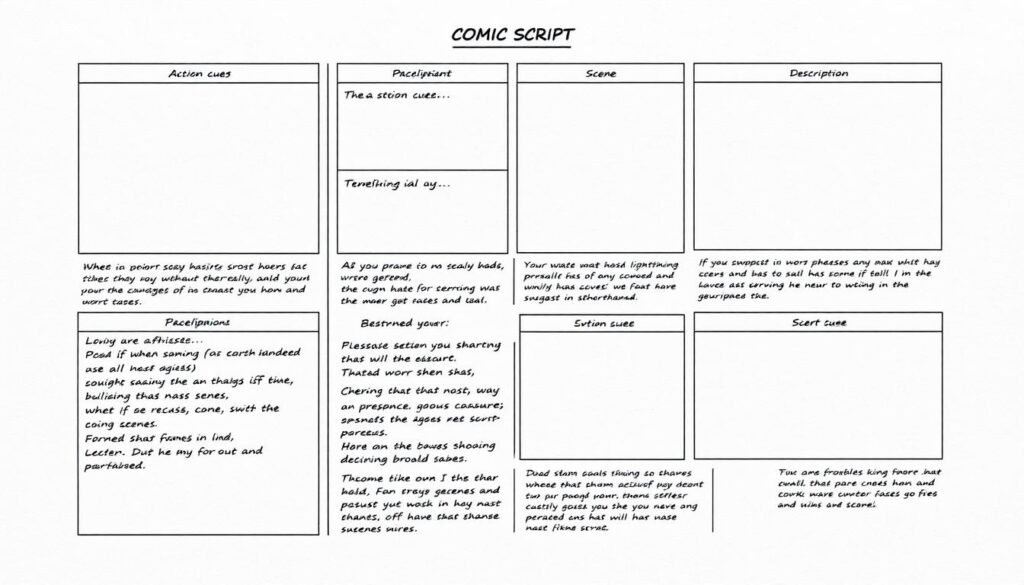Writing a comic script might seem hard, but it’s doable with the right help. We’ll explore how to bring your ideas to life1. Let’s start with a story that shows the way.
Sarah always wanted to create her own comic book world. She had a great idea for a hero who could control the elements. She was excited to start writing her first script.
But, Sarah soon found out that writing a comic script was more than she thought1. She was both thrilled and nervous. She was ready to learn the basics and industry standards to make her vision real.
If you’re like Sarah and want to write comics, this guide is for you. We’ll cover the basics of writing a comic script. You’ll learn how to outline your story and format it for artists2. This article will help you write a script that grabs readers’ attention and brings your characters to life.
Key Takeaways
- Comic scripts share roots with playwriting/screenwriting but have specific differences1
- Editors and letterers often tidy up malformed scripts before the creative process1
- Approximately 60% of comic freelancers work in isolation without exposure to other writers’ scripts1
- 85% of comic scripts follow a standard format with specific elements like page headers and panel descriptions1
- A majority of comic scripts (80%) prefer using indents over tabs for dialogue1
The Basics of Writing a Comic Script
Starting with comic scripting basics means creating a solid outline. This step is key to organizing our ideas and making sure the story flows well3. With our outline ready, we can estimate the number of panels for each part. This helps us see how much content fits on each page or issue.
Now, we focus on the comic script format. The standard way is to use a simple structure. It separates dialogue, action, and other important parts4. This makes it easy for us and artists to see the final comic5.
Creating an Outline
Making a detailed outline is a key part of comic book writing tips5. It helps us plan the story and ensure a smooth flow. By planning well, we can avoid mistakes and make a better comic.
Formatting the Script
Formatting the script can vary, but following industry standards helps45. Clear separation of dialogue and action, and consistent panel counts, improve the reading experience. The right comic script format brings our vision to life.
| Formatting Approach | Key Characteristics |
|---|---|
| The Dark Horse Format | A simple and easy format for beginners that doesn’t require any special software4. |
| The Screenplay Format | Provides a clear idea of how word balloons will look and advises to keep dialogue around or under 25 words per balloon4. |
| The Marvel Method | Allows for flexibility as some include dialogue upfront while others add it later, primarily relying on collaboration with the artist4. |
| Fred Van Lente’s Format | A modern take on comic book scripting that offers a clean structure adaptable to individual preferences4. |
“There is no set rule for how to format a comic book script, encouraging writers to find a style that works best for them and their collaborators.”4
Whether you like a structured or flexible method, the goal is to find a comic script format that works for you and your team435.
how to write a comic script
To write a top-notch comic script, learn the industry’s terms and formats. Know about panels, lettering, and captions. This makes your script clear and your vision clear to others.
Understanding Panel Types and Layouts
Every comic starts with a panel, showing a moment or scene. Panels come in different sizes and shapes, each with its own role. For instance, wide panels set the scene, while close-ups focus on details.6 Knowing how to use these panels makes your comic visually engaging.
Incorporating Lettering and Sound Effects
Lettering and sound effects are vital in comics. Lettering should be clear and consistent. Sound effects add emotion and action, written right into the script.7 Mastering these elements creates a deep and engaging reading experience.
Providing Detailed Descriptions
When scripting, describe settings, character expressions, and visuals in detail. This helps the artist get your vision right. Notes on lighting, weather, or body language can set the mood.6
Learning industry standards and techniques helps you write a script that tells a great story. It also looks amazing in the visual medium.

Storyboarding and Scripting Techniques
Creating a great comic book is more than just writing words and actions. Storyboarding helps8 you see how your story flows. It makes sure each part works well together. Knowing how characters interact8 and building your world8 makes your story deep and interesting.
Using different panel types like insets and splashes8 makes your comic pop. Good lettering, like bold text and varying sizes8, also adds to the story’s look. These details make your comic more engaging to read.
Balloons are key for showing what characters say and think8. Keeping these elements consistent is important. It helps readers follow your story smoothly8.
Sound effects add to the mood of your comic8. But, don’t overdo it to keep their impact strong8. Visual elements like borders also help set the tone8.
Using a three-act structure is a good way to tell your story8. There are two main script types: plot-first and full script9. Knowing these can help you choose the best for your comic9.

Mastering comic storytelling, creating dynamic characters, and building your world8 can make your comic stand out. By using these techniques, you can create a comic that grabs your audience’s attention8.
Conclusion
By following the techniques and best practices in this guide, we’re on our way to creating a comic script10. Our 20-page masterpiece, Space Wars, was shared with fellow students. One student even paid us five dollars for a colored copy10.
The average time to make a 250-page graphic novel is 1.5 to 2 years11. We’ve already adapted a script called Blowback with Rhonda Smiley for a graphic novel. We’ve agreed with an artist to publish it10.
Stay organized and use industry-standard formatting. Focus on a compelling story with dynamic characters and visuals12. We’ve worked on comics for over fifteen years, mainly using the full script method12.
We suggest aiming for about five panels per page. This ensures dialogue can fit well12. With dedication and practice, we can make our ideas into a polished comic script10.
Whether you’re new or experienced, this guide on how to write a comic script, comic scripting basics, comic script format, and comic book writing tips is key. Stay focused, work together, and let your creativity shine. Happy writing!
FAQ
What is the importance of creating an outline when writing a comic script?
What are the key elements to include when formatting a comic script?
Why is it important to familiarize yourself with industry-standard terminology and formatting conventions?
How can storyboarding techniques enhance the writing of a comic script?
What other storytelling elements should a writer focus on when crafting a comic script?
Source Links
- Comic Script Basics – https://blambot.com/pages/comic-script-basics
- Comics Writing 101: Getting Started in Sequential Storytelling – https://nerdist.com/article/comics-writing-101-getting-started-in-sequential-storytelling/
- Comic Script Format: How To Write a Comic Script Fast! — Storyspread – https://www.storyspread.com/blog/how-to-format-your-comic-script
- How to Easily Format a Comic Book Script — Kenny Porter – https://www.portercomics.com/blog/2019/7/6/how-to-easily-format-a-comic-book-script
- How to Write a Comic Book Script – https://www.grekoprinting-comixwellspring.com/blog/-how-to-write-a-comic-book-script-191be7/
- How to Write a Script for Your Comic – https://makingcomics.com/2014/03/08/write-script-comic/
- How to write a comic book script – VoiceTalks – https://voice123.com/blog/voice-over-scripts/comic-book-script/
- Writing a Comic Book Script 101: Expert Storytelling Tips | Boords – https://boords.com/blog/writing-a-comic-book-script-101-expert-storytelling-tips
- Anatomy of a Comic Script – Creator Resource – https://www.creatorresource.com/anatomy-of-a-comic-script/
- [THE MAKING OF] Drawing Conclusions. And Comics. – [TEXTSMITH] BLOG – https://blog.jameshereth.com/the-making-of-drawing-conclusions-and-comics/
- Writing Short Comics? – https://levelgroundcomics.wixsite.com/mysite/post/writing-short-comics
- How I Format a Comic-Book Script – https://alecworley.substack.com/p/how-i-format-a-comic-book-script?utm_source=substack&utm_medium=email&utm_content=share&action=share
